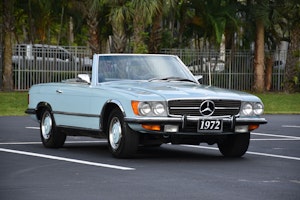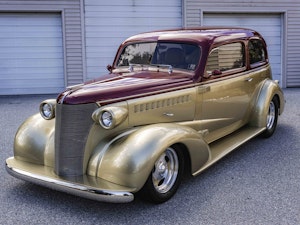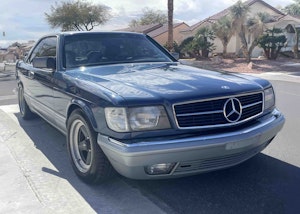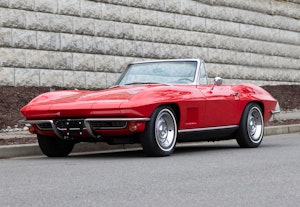Media | Articles
Driving the aero Corniche that has enchanted Bentley bosses for 80 years
Nothing survives for 80 years without a bit of back story, but this 1939 Bentley Corniche has boatloads, mainly of it being repeatedly crashed…
For that reason, as well as being the first Bentley outsider to drive this remarkable car, I’m experiencing a certain amount of trepidation at the wheel of this “production” Bentley, which never actually went into production, was crashed twice and bombed once. As Robin Peel, head of Royal and VIP relations at Bentley tells me, “You are now part of the test team.”
So what’s it like?
Hot, certainly. Even between repeatedly binning this car, Bentley’s pre-World War II test drivers noted the stifling cabin. There’s actually no record of what the interior looked like, but it’s a fair bet that Darren Day, Bentley’s interior design head, who took charge of reimagining a contemporary (and beautiful) cabin, didn’t manage to stick in an extra vent, or air conditioning.
Those testers also noted strange aerodynamics, which whooshed air around the back seats if a rear window was opened, and there’s a suspicion in Bentley circles that the high-speed stability of the Corniche (named after the French mountain roads) was compromised, too, though in an early test at the banked Brooklands track in Surrey it managed 111 mph without too much drama.
Marketplace
Buy and sell classics with confidence
20191211221450)
No one really knows. It’s only gone eight miles since it was rebuilt with the correct and original special lightweight chassis, specially-tuned engine, and four-speed overdrive gearbox, which—as Ken Lea, Chairman of the WO Bentley Memorial Trust, former Rolls-Royce/Bentley director, and a man intimately involved with the recreation, explains—isn’t there to make the car go faster, but to restrict the revolutions on this slightly fragile engine.
“This was a production car,” Lea says. “There were several bodies and chassis prepared and a series of debuts planned for the autumn of 1939 at motor shows in Paris, Earls Court, and also New York.” One source even suggests there were plans to run a works team of Corniche models at Le Mans in 1940.
But then a series of unfortunate events occurred…
The first was in July 1939. After Brooklands, the Corniche was shipped to France for high-speed road testing, but within a couple of days an unfortunate Bentley test driver encountered a truck turning in front of him, and the car suffered mild damage. It was sent back to Carrosserie Van Vooren for repairs and improvements, but a month later, on its way back to Bentley’s testing HQ at Châteauroux in central France, a car pulled out and the poor Bentley driver was forced to swerve into a ditch, where the car hit a tree and rolled over, sustaining severe damage.
It was swiftly dismantled, with its lightweight chassis returned to Derby and the body to a local repair shop. Then World War II broke out.
20191211221836)
Bentley, which had been purchased by Rolls-Royce in 1931, announced that it would be finishing car production to concentrate on the war effort. The French body shop, however, continued to repair the coachwork and delivered it to Dieppe, where ferries were still plying the Channel, in May 1940. A paperwork glitch stranded it there though, and the warehouse where it was stored was bombed, destroying the bodyshell.
That could have been the end of it. Bentley’s remarkable experiment into aero design might have disappeared without a trace, and a historic link would have been lost forever. How so? Many students of Bentley history see this car as the link between the pre-World War II upright Bentleys—with enormous radiator grilles and moustachioed, pipe-smoking drivers, typified by Russell Brockbank’s cartoons—and the elegant sophistication of the John Blatchley-designed R-Type and S1 Continental of the ’50s.
The Corniche came about as a result of advances in aerodynamics, as well as increasing warranty claims on Bentley’s separately bodied cars. Robert Harvey Bailey, then the head of Bentley’s chassis division, was keen to adopt a more empirical approach to design and engineering. Besides, Bentleys were starting to look old-fashioned and stuffy, and the company was under pressure for more exciting designs from dealers such as Walter Sleator, MD of Garage Franco-Britannique, the Rolls-Royce/Bentley agent in Paris. In response, Bailey gave an unofficial nod to the creation of a remarkable-looking fixed-head coupé, commissioned for André Embiricos, designed by George Paulin and built by Marcel Pourtout’s Carrosserie Pourtout in West Paris.
Paulin, a French dentist, talented car designer, and wartime resistance hero, was already a phenomenon in aerodynamic car styling, although his gorgeous early studies for Peugeot, Talbot Lago, and Lancia weren’t desperately wind-cheating. The Embiricos Bentley was so well-received by the press, though, that Bentley asked to inspect it. The engineering department pronounced it fast but under-geared and uncomfortable.
20191211221540)
20191211221713)
20191211221639)
Paulin was commissioned by Bentley to come up with another aero design, to be fashioned by Carrosserie Van Vooren in Paris and fitted to one of three chassis made of thinner-gauge steel than the standard Mark V Bentley. It was to be powered by a tuned version of that car’s 4¼-liter, six-cylinder engine, with the long-geared four-speed transmission and independent wishbone front suspension.
Slightly inconvenient for the “missing link” story, however, is the fact that there were actually four other Van Vooren bodies built and stored at Châteauroux, which remarkably survived the war, although Bentley—having no need of them—destroyed them at the end of hostilities. It kept the other three chassis, however, as well as the special parts and engines on the shelves at Derby, selling them on to a handful of specialists when parent Rolls-Royce went bankrupt in 1971.
So when, in the early 2000s, Rolls-Royce chairman Sir Ralph Robbins blew his 4¼-liter engine up at a race meeting, Ken Lea found that the spare engine he’d bought from a specialist and was offering to Sir Ralph was, in fact, a special one from the Corniche. He suggested to Sir Ralph that they should try and rebuild a Corniche model and received assent. Lea already had the official “List Of Parts,” which documented everything fitted to the Corniche, as well as the test drivers’ reports, and the Paulin family released George’s drawings to the project, which involved The Rolls-Royce Heritage Trust, the W.O. Bentley Memorial Foundation, Rolls-Royce Bentley, and the Henry Royce Memorial Foundation.
The going was depressingly slow, however. In addition to the unknown interior design, there were no color pictures of the car, and the only record of its vented underbody structures and complex exhaust pipes were the pictures taken after the crash. The project was also ruinously expensive. The chassis was built up at the Rolls-Royce Heritage Trust, and Ashley and James of Lymington in Hampshire delivered the body, but if not for the skilled—and volunteer—labor, Lea admits he might not have lived to see the reborn Corniche running.
20191211221748)
The project was still languishing as preparations were made for Bentley’s centenary this year, and it was brought to the attention of Adrian Hallmark, Bentley’s new chief executive. After examining it, he gave permission for the Corniche to be brought to Bentley’s bespoke arm Mulliner to finish. Well, that’s the official story; but it took resources from all over the firm as well as outside it and the remarkable talents of Mulliner’s Neil Sims to get the car up and running. Seats and trim were done by Mulliner, and after much research they decided upon this claret-red and pink-grey combination; it’s much better in the metal than it sounds.
Where records were scant, there was inspired guesswork and, heeding Lea’s test driver reports of engine overheating, the radiator grille bars were opened to improve the cooling. The car was finished in time for a brief appearance at this year’s centenary celebrations, followed by a drive at the Salon Prive event at Blenheim House in September, with Sims at the wheel.
And now I’m sitting in the hot seat, turning that Yale ignition key, pressing the nickel-plated starter button, and listening to the big six churning slowly and (just) catching. It’s running rich to protect it during the running-in process, but it’s tricky to pull away with the heavy clutch and almost-counterintuitive ignition advance/retard controls. Still awaiting road registration with its original licence plate (GRA270), we receive permission from the nearby Cholmondeley Castle to use its estate roads. It once held a speed hill climb. “Just try and avoid the dog walkers,” says James Hall, the estate manager.
The Corniche rides pretty well but stiffly at the front, and I suspect there’s a bit more work needed on the damping and springing. The steering is lovely, though—precise and accurate, with a gorgeous thin-rimmed wheel. In fact, the car’s not been out of second gear since the rebuild, so Sims encourages me to take third and push the revs a bit beyond 2000 rpm. At once, the car sits back on its rear suspension with all the expectation of a bird dog on a leash. The ride smoothes out, and the engine loses much of its temperament as the exhaust note deepens. Out of the lovely opening front windshield, vistas of long cross-continental journeys seem to open—of gilded wealth, of Fortuny silk dresses, Savile Row tuxedos, and supper on sloping Long Island lawns. Well, we can all dream, but surely this is the sort of car that Dick and Nicole Diver from F. Scott Fitzgerald’s Tender Is the Night would have driven along the Promenade Des Anglais in Nice.
20191211222010)
One press of the middle pedal brings it all back to earth, since the brakes are pitiful and demand an almighty heave to bring the Corniche to a halt—don’t crash it!
“I’m absolutely over the moon that this car has been done,” Lea says, although we both agree that there’s still a lot to be done. The cabin is beautifully realized, but you can’t pull the handbrake on without scraping your knuckles against the leather, the doors don’t open far enough, and the chassis and engine need committed and painstaking toil by Sims and the rest of the team.
But what a strange attractor it is. Commissioned by one of the great Bentley engineering bosses, the Corniche’s beauty has put two separate Bentley bosses under its spell and caused them to order its expensive recreation. Let’s hope they all maintain the commitment and resources to finish the Corniche as properly as it should have been and that one day it purrs down a tree-lined French Routes Nationale without crashing even a tiny bit.
20191211221510)








20191211221432)
20191211221440)
20191211221500)
20191211221520)
20191211221529)
20191211221553)
20191211221602)
20191211221614)
20191211221627)
20191211221658)
20191211221732)
20191211221810)
20191211221857)
20191211221949)
20191211221956)
20191211222002)
20191211222017)
20191211222024)
20191211222054)
20191211222101)
20191211222109)
20191211222118)
20191211222131)

